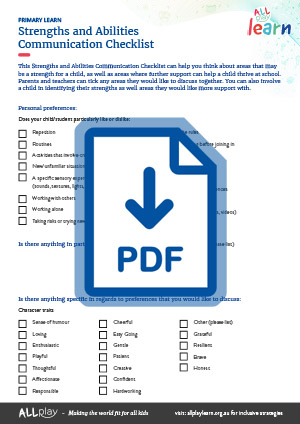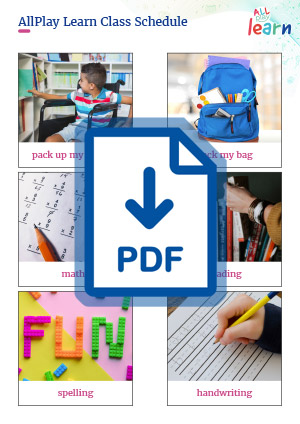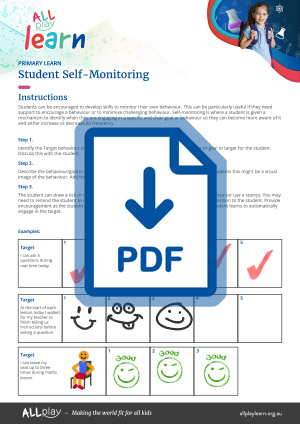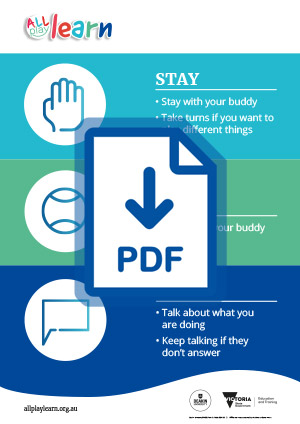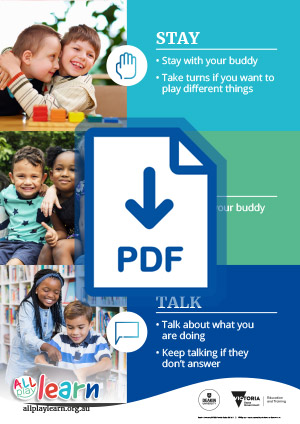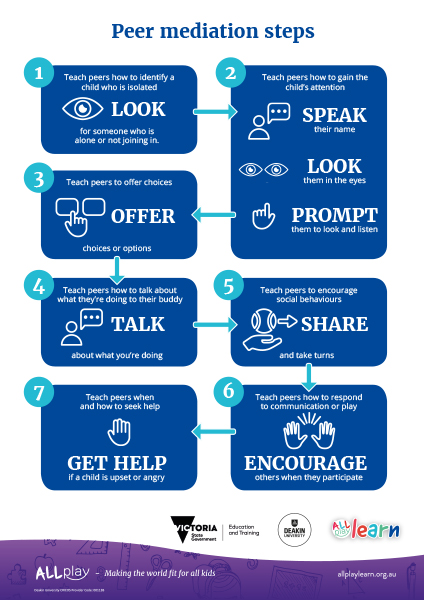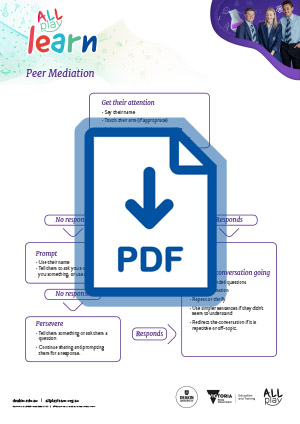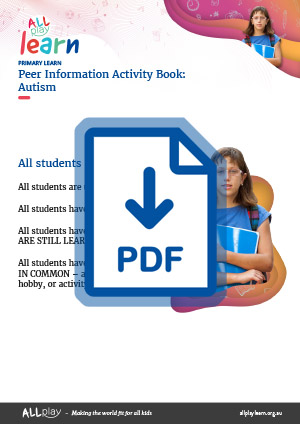

About autism
Autism is a condition which impacts the way a student may experience and interact with their environment and others in their environment. Every child with autism is different, there is no ‘one size fits all’. This means that the characteristics of autism may differ significantly from one student to another.
Students with autism typically experience differences in their:
Students with autism typically experience differences in their:
- Initiations and responses during communication. Some students might have lots of language and others might only use a few words or no words. Autistic students tend to speak very honestly, and may misunderstand others when language isn’t direct (e.g. sarcasm or jokes). They may take longer to understand communication, and some students may make statements that don’t fit the flow of conversation or context.
- Interpretations and use of nonverbal communication. Autistic students may avoid or dislike eye context, their facial expressions may be less expressive than other students, and they may not use gestures (e.g. pointing) when communicating. Students may become frustrated and distressed when their attempts to communicate verbally or nonverbally are not understood, which may result in challenging behaviours.
- Interactions and understanding in social contexts. Students with autism may misunderstand social interactions, including unspoken social rules or conventions. They also may not perceive and follow the ‘rules’ of conversation, such as taking turns. Although they may have social difficulties, they may play alone or alongside others - they are often keen to join in, they just might not know how.
- Behaviours or interests. Students with autism may follow routines and class rules well as they tend to like things to be done in a particular way or order. They may have a favourite activity that they are happy to do over and over again, and they may need warning before switching between tasks.
- Reactions to sensory input Some students may find loud noises or particular sounds or textures uncomfortable. As every student with autism is different, it is important that the teacher understands the student’s sensory needs, to provide appropriate supports and ensure the classroom environment is inclusive.
A note on language. How you speak about autism is an important issue to many. Some autistic people and families prefer ‘autism’ over ‘autism spectrum disorder’. Some students and their families prefer a person-first approach, where you refer to the person before their diagnosis — so ‘student with autism’. This puts the focus on the young person, rather than his or her diagnosis. However, others may prefer identity-first language, so ‘autistic student' rather than a ‘student with autism’. This is becoming increasingly common and can help individuals to claim their disabilities with pride, whilst challenging negative stereotypes about autism. For more on language visit AllPlay Learn's inclusive anguage guide.
Some autistic students may have learned to 'mask' (hide or camouflage) their autistic characteristics, which can have a negative impact on their wellbeing. Learn more about what masking may look like, and tips on how to support a student who is masking, in this brief overview of masking.

Strengths
What might be some strengths?
- Some children may have good visual perceptual skills. They may be good at visual searches and recognition.
- Recognising different sounds and music can be a strength.
- Some children may be good at recognising patterns and solving problems.
- Children with a strong interest in a particular topic may have learned lots of information about that topic.
- Some children may provide new or interesting responses to creative tasks (e.g., creating new metaphors).
- Understanding and reasoning about physical objects or properties may be a strength.
Where you can provide support
- Some children might find it hard to fit in socially. They may find recognising or understanding the emotions of others challenging without help.
- They might have difficulties expressing themselves or understanding the meaning of things said to them. They tend to learn well with concrete, rather than abstract, examples.
- They may find it harder to know when or how to join in activities with other children. This means they may keep to themselves if they’re not shown how to join in or play within a group.
- Some children may not make eye contact.
- They might find it harder to understand instructions. They benefit from support in using a skill they learned in one task or context in another context (generalisation).
- They tend to be less unsettled when plans are changed or they need to move between tasks when they are warned about the change.
- They may be sensitive to certain sounds or other sensations.
- Some children may struggle with motor tasks such as writing or drawing.
- They may become easily overwhelmed and have emotional ‘meltdowns’

Evidence-based strategies
Consider adjustments to communication style
Tailor activities to be as inclusive as possible
Provide positive feedback
Provide lots of opportunities to practise
Work collaboratively
Support students to self-manage
Support to develop social skills
- Visual cues. Visual cues and schedules can help students understand what is coming up, how to complete an activity, and when they should complete a transition from one activity to another. See AllPlay Learn's printable class schedule.
- Give a warning when a transition is coming up. Children who find it difficult to move from one activity to another often feel less unsettled if they are warned about the transition (for example: “in two minutes we are going to pack away and go to art”). Provide clear instructions about the transition.
- Some tasks may need to be modified for a student. Where you can, use concrete materials (such as images to supplement text, blocks to model maths), rather than abstract concepts. Where needed provide simplified text and pictures showing how to complete a task.
- Where possible, add child interests or choice into the learning process. For example, if a student is motivated by cars, offer a small bundle of toy cars for addition and subtraction, and when the student completes their maths, encourage them by giving them some time to play with the cars.
- When a task is new, some students will learn best with support. Provide them with support (i.e. prompts, in-person and video demonstrations, encouragement). This can be gradually reduced as they become more capable. Support can be provided by teachers or other students.
- Give encouragement and correction. Consider giving positive feedback and correction immediately when children are learning a task or behaviour. This can be reduced gradually as they build their capability.
- Encourage using interests. Some children may be highly motivated by their interests. Consider letting a child engage in an activity related to their interests as an encouragement for their efforts.
- Express positive regard and support. Teacher emotional support and encouragement helps a student with autism achieve better results. Help a child know that they are valued and supported.
- Students may need to practise a task or behaviour many times. Lots of time to practise in different settings and with different materials can help students learn to use that skill in other situations.
- Offer fewer tasks with more opportunities to practise. This helps children to learn tasks and may be more helpful than offering many tasks with little opportunity to practise.
- Help them by using one-to-one attention.
- Provide lots of opportunities for students to work together. Children with and without autism can get to know each other and build friendships through working together. Students can also learn through watching others. Consider ways in which you can facilitate a child’s interactions with others in a group. See AllPlay Learn's peer mediation and group work page for tips on this.
- When appropriate, give individualised tasks. Consider giving specific roles or tasks to students in a group if a student with autism is working with tailored materials or instructions. You could also select a student in a group to be a tutor or mentor.
- Teach self-instruction skills. Consider guiding students to problem solve so they can persist with schoolwork instead of getting frustrated. For example, they can follow these steps mentally or think out loud: “What is the problem?”, “What are my options?”, “I think this is the best option”, “Am I following my plan?” and “How did I do it?”
- Teach students how to self-monitor. Consider giving children a checklist of behaviours that they would like to work on. Prompt them to check off the list throughout the day. View AllPlay Learn's self-monitoring form below.
- Provide instructions to students about strategies they can use when taking tests.
- Class passes. Provide students with visual cards that allow them to take an additional break during classroom activities.
- Allow noise-reducing headphones. Noise-reducing headphones may help students if they find the classroom or playground too loud.
- Use social stories. Social stories can help students understand what is likely to happen and how they can respond in specific situations.
View an example of practice demonstrating how a teacher can use a strengths-based approach to apply evidence-based strategies to support a student with autism and intellectual disability.

Best practice tips
Provide a safe space
Support children to learn social behaviours
Minimise background noise and distractions while giving instructions
Ask how to help
Teach learning strategies
Introduce transitions gradually and with support
Create a classroom space that supports engagement
Self-disclosure
Use technology
Promote self-determination
- Consider providing a quiet area that a child with autism can access to support them if they feel overwhelmed. Having access to a trusted adult can also support students when they are feeling overwhelmed. Use our anxiety resource toolkit to recognise and support child anxiety.
Consider prompting children to use social behaviours, such as asking another child to play, share, or wait their turn.
This can help all children hear and focus on the teacher. You might need to face the group away from distractions behind you.
- Talk to parents and the child’s support team to find out the best way to work with and support the student.
- Parents can help you understand a child’s unique strengths and areas they need more help.
- You could ask parents to complete AllPlay Learn’s Strengths and Abilities Communication Checklist.
- Use learning and memory strategies that allow students to complete tasks independently. For example, task analysis can be used to break down a skill the student is learning, and mnemonic devices can be used to help the student remember theories.
- Primary school settings tend to involve multiple transitions between activities and settings across the day.
- Introducing additional transitions throughout the school day gradually, and using supports such as visual schedules, social stories, and verbally letting students know when a transition is approaching, may be particularly important when students first begin attending school.
- Visit AllPlay Learn's Transitions Throughout the School Day for other strategies.
- Consider trialling (and monitoring) changes to the classroom environment. This may include creating designated spaces for specific classroom activities, providing enclosed areas that reduce distractions, providing spaces with dimmable or reduced lighting, and reducing detail in visual displays.
- Some students may choose to disclose their diagnosis to peers. This can be a positive or a challenging experience for students. Understanding the student's experience of disclosure, to provide support if needed, may be helpful.
- Read 'Helpful or harmful? A scoping review of perceptions and outcomes of autism diagnostic disclosure to others' to develop your knowledge about some of the positive or negative experiences that other autistic students and adults have experienced when disclosing their diagnosis to others.
- Watch Ellen's story about sharing her autism diagnosis with others.
- Consider how technology may support a student’s organisation and planning. For example, consider the use of software or apps that can help a student to keep track of their homework tasks, or the use of a silent vibration alert on a watch to support them with self-monitoring.
- Promote self-determination. Empower and teach children to make simple choices, set goals, be independent, and develop problem-solving abilities. Use technology as needed. For example, technology can be used by students who communicate non-verbally to indicate preference.

Curriculum considerations
- Children with autism may find loud noises during music and dance, or some textures in art, overwhelming.
- Consider providing choices regarding activities and materials. A quiet space or noise-reducing headphones may help some children.
- Other tips and resources can be found at AllPlay Move:Dance.
- Some students may need support with reading comprehension. Consider using a story map for important story elements such as the main characters, setting, beginning, middle, end. Ask comprehension questions and provide prompts that increase in support when needed (i.e. start with an open question, and move to a choice of two options if needed). Tactile and visual supports that link to the story and encourage student interaction may also be helpful.
- Some students with autism find pronouns (a word that replaces a person or object, such as I, me, or you) challenging. This is possibly because children with autism often echo other people’s speech and have trouble understanding the social rules of language. They may need help to identify the pronouns when reading.
- Provide lots of time to practise.
- Children with autism may need help to use strategies or skills they learned in one task in a new task.
- Children may learn a new movement skill more easily if they are given a picture card of that skill just before they start practising. Give them one picture card at a time if learning several new skills.
- It may help to pair a child who is finding it hard to learn a new skill with a child who can help them learn that skill. The other child can help break down instructions, model a skill, and affirm for correct attempts. See AllPlay Learn's peer mediation and group work for important tips on pairing children together.
- Consider adjustments to communication style and tailor activities to be as inclusive as possible.
- Our AllPlay Footy resources, including a video outlining the common concerns of parents of kids with autism, can help you engage students with autism in footy and other sports activities.
- Some students with autism may have much knowledge in an area of the humanities curriculum if it is one of their special interests. This can give them an opportunity to share their knowledge with others.
- Children with autism who have communication challenges may need support with learning a new language.
- Assess whether learning a language will be of advantage to them on a case-by-case basis.
- If they are learning a language, focus on areas of strength and build from there.
- Some children with autism may find it difficult to connect an image of a number with ‘how many’ (the quantity) it represents. Dots/lines indented into a written or printed number can help them learn by pointing to or touching each dot/line to count ‘how many’.
- Provide lots of time to practise.
- Children with autism may need help to use strategies or skills they learned in one task in a new task.
- Provide positive feedback and provide lots of opportunities to practise.
- Visuals can support students by acting as a concrete example of the mathematics problem in action.
- Children with autism may need help to use theory or skills they learned in one task in a new task.
- Some children with autism may have much knowledge in an area of the science curriculum if it is one of their special interests. This can give them an opportunity to share their knowledge with others.
- Many children enjoy digital technology and will be motivated by this subject.
- Some children with autism may have much knowledge about technology if it is one of their special interests. This can give them an opportunity to share their knowledge with others.

Other considerations
First aid
Safety drills
Behaviour
Relief teachers
Friendships
Excursions/camps
Transitions
Other co-occurring conditions
- Consider sensitivity to smells and textures when giving first aid to a student with autism. Some students may be distressed by blood or bandages or refuse to have an ice pack or medication.
- Talk to a child’s caregivers to identify the best way to manage an injury/illness.
- Children with minimal language may have difficulty communicating that they are in pain or unwell. Watch for signs of pain such as grimacing, and encourage gestures or other methods of communication to work out what may be happening.
- Unexpected safety drills may upset some children with autism.
- Consider letting a child know beforehand that there will be a drill.
- Pair them with a buddy or person they feel safe with.
- Noise-reducing headphones may help if they find the noise of the alarms overwhelming.
- Some children with autism may not know how to tell an adult if there is an emergency, or what to do in an emergency or emergency drill. Consider making time for demonstrating and practising what to do.
- Identifying what may be causing a child’s behaviour can help both the teacher and the child feel less frustrated.
- Some common causes of challenging behaviour include difficulty in communicating their wants and needs, feeling anxious, sensory overload, trouble understanding or working on a task, or not understanding the rules or expectations.
- Encouragement and acknowledging positive behaviour may help. Encouragement that is linked to a student’s interests may be particularly helpful.
- Refer to the ABC approach for more information on how to reduce challenging behaviour by supporting the child and promoting more helpful behaviour, and our emotions page for more information about supporting a child with managing their emotions.
- A child with autism may find having a different teacher and changed routine upsetting.
- Telling relief teachers about the specific routines and teaching tips that will help that child may prevent distress.
- See AllPlay Learn’s story When my teacher is away
- A child with autism may face challenges with friendship dynamics or feeling different. Teachers may need to help facilitate and navigate friendships.
- Provide universal and targeted bullying prevention. Increasing the understanding of students, families and staff about disability, and providing peer-mediated interventions against bullying, helps create a positive school culture that supports positive peer inclusion.
- Explicitly teach students about friendship, emotions, and social interpersonal problem solving.
- See AllPlay Learn’s social inclusion resources
- See AllPlay Learn's Being different story
General tips
- A child with autism may benefit from supports when moving across education settings.
- It may be helpful to teach and practice organisation and homework skills, and time- and self- management skills.
- For more information about supporting students with disabilities when transitioning to a primary or secondary school setting access AllPlay Learn's transition page.
- For children transitioning to primary school access AllPlay Learn's Story A school day, and for children transitioning to secondary school access Access AllPlay Learn’s story How to be organised
To support a student with transitioning into your school or classroom setting:
- Hold a transition planning meeting prior to the transition to engage in student-centred planning with the student and their family, former education setting, and when relevant, their health professionals.
- Provide multiple opportunities for a student and family to visit their new school and teacher before the transition to help the student become familiar with the new setting, and to establish communication and partnership with the family.
- Identify a point of contact for parents throughout the transition process, and provide more frequent communication (e.g., daily) with parents early in the transition.
- Provide personalised transition supports, such as time to visit the new school and teacher multiple times, providing visual schedules or timetables, and access to a staff member, safe space, and peer buddy.
- Ask parents to share key information about the student’s strengths, interests, and specific strategies that have been helpful and preferred by the student (e.g., sensory adjustments). Ask parents to complete AllPlay Learn's Strengths and Abilities Communication Checklist.
- Monitor the student’s transition into your classroom. Signs that the student has made a successful transition include positive and respectful relationships between the teacher, peers, and the student, continued academic achievement within the same level (or only slightly lower), and the student knowing key school buildings and staff or students well.
To support a student with transitioning out of your school or classroom setting:
- Hold a transition planning meeting prior to the transition to engage in student-centered planning with the student and their family, new education setting, and when relevant, their health professionals.
- Support the student to identify and practise coping strategies that help them manage any difficult emotions at school.
- With written consent recorded, share key information about the student with their new setting, using strengths-based language to identify their strengths, interests, and specific strategies that have been helpful and preferred by the student (e.g., sensory adjustments). Use AllPlay Learn's Strengths and Abilities Communication Checklist.
Some children with autism may also experience anxiety, Attention-Deficit/Hyperactivity Disorder (ADHD), intellectual disability or oppositional defiant disorder.

Relevant resources
Visit our resources page for a range of resources that can help to create inclusive education environments for children with disabilities and developmental challenges. AllPlay Learn’s stories can help children with autism become familiar with primary school and some of the skills they need to participate in these settings. Other relevant resources for children with autism are:

